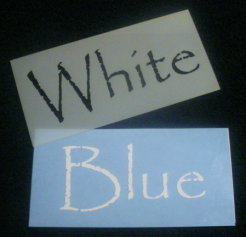This section will lend a helpful hand to anyone who is "Brand-Spank'in" New" to stenciling. Here you will learn some terms and techniques that will help you along the way. So, let's get started and begin to learn! **please bear with me here as I try to get this done as quickly as possible...Just keep checking back and follow along.**
What is a Stencil?
A stencil is a thin sheet of material, such as paper, plastic, cardboard or metal, with letters or a design cut from it, used to produce the letters or design on an underlying surface by applying pigment through the cut-out holes in the material. The key advantage of a stencil is that it can be reused to repeatedly and rapidly produce the same letters or design. The design produced with a stencil is also called a stencil.
Stencils can be Hand-Cut (using a tool like an Exacto Knife, Scalpel, Sissors..etc) - Machine Cut (larger cutting machines found in factories that uses various types of blades-used often for mass production) or Laser Cut (using the output of a high-power laser at the material to be cut. The material then either melts, burns, vaporizes away, or is blown away by a jet of air.)
***
Here at HorseyFeathers, we use 7 Mil Mylar to make all of our stencils. We offer Translucent (see thru) White, Translucent Blue and Clear Mylar. The stencils we sell in our eBay Store, our on-line store, HorseyFeathers.com and from our shop here in Indiana will either be Translucent White or Translucent Blue.
***
So, What is Mylar?
Mylar is a type of thin, flexible, durable plastic. Flexible allows you to paint not only on flat surfaces, but round ones too...like Candy and Cookie Tins and Round Paper Mache Boxes! It comes in variable thicknesses, colors and is washable for reuse at a later time. It stores well and with proper cleaning and storing of your stencils you can use them over and over and over again!!
***
5 Mil vs 7 Mil - Which is better?
I'm not convinced that one thickness is "better" for stenciling than the other. Both Mil's will stencil just fine...however, 7 Mil Mylar may have more Tinsel strength than 5 Mil Mylar. Tinsel strength helps to determine the amount of pull on something before tearing away. A human hair has tinsel strength and so does Tyvek Paper. Both can be pulled apart, just one is easier than the other. Here, we're talking about a stencil. We're simply going to use it to paint on something, wash it (maybe) and put it away!
Now, let me just say this...If I were to paint a large flower on a privacy fence outside on a windy day, then I would appreciate the added tinsel strength of 7 Mil. If I store my stencils in a big drawer and I'm constantly, sorting thru them to find a certain one, then I'd want 7 mil, especially if they're just loose and not in stencil sleeves. If I'm doing a project that has lots of very small ( .25" or smaller ) areas to stencil, then I might appreciate the 5 Mil a little better, only because it's thinner, and I might get more of the smaller images...like tiny stars, dots, eyes...etc. onto my project. Again, that's just my take on mil thickness, respective for use with stenciling.
***
My Stencil has "Bridges"?
If your stencil has words, letters or numbers, then it most likely will have bridges! We know a bridge as connecting two pieces of land together. So, for simplicity here is the best explanation of a "Stencil-Bridge" and why you need bridges in your stencils...
...nuf said!
***










